Our time in India started in New Delhi, the city many travelers you meet on the road tell you to skip. Though we’d been warned that Nepal was dirty, we’d been warned that Delhi was worse, filled with scammers, robbery, food poisoning, and trash. Like Nepal, I found myself cringing as I heard how fellow travelers described Delhi, certain that I would be able to see the beauty in the midst of the chaos as I did in Kathmandu. As it turns out, my beauty radar malfunctions when I am ill, and the “Delhi belly” that travelers warned us about caught both Kirk and I within a two days of being in the city.
Arriving in Delhi, I was so curious to wander down the streets of the second most populated city in the world, home to around 28.5 million individuals. There are many streets in the city that are always busy and bustling and the idea of elbowing my way through the crowd in efforts to experience the everyday life of individuals in Delhi sounded like an experience I’d like to have once. However, in getting sick (and recovering from illness), aspirations of doing something a little stressful disappeared, and being forced to do so anyway (due to the need for food and water) caused a bitterness to well up that was quite hard to not to apply to everything else around me. I left Delhi with a pretty terrible taste for the city, and this blog will likely show some of that, but I still wouldn’t say that Delhi isn’t worth visiting. There are plenty of sides to the city that we never saw (due to illness), and alongside that, I’d like to think that there is always something to experience and learn from, even in negative experiences. For me, perhaps the biggest insight of all during our time in Delhi is that what I experienced as “bad” is everyday life for millions of people – and that’s a humbling thought. This dichotomy of negative encounters and positive thoughts led to the following account of our time in Delhi, it was certainly an interesting experience.
In Delhi we stayed at a hotel in the middle of the Main Bazaar area. In the evening, this area is bustling beyond belief. Tuk tuks and taxis push their way through crowds of people, street vendors set up in what should be road space (though the roads never actually shut down), people on bicycles and motorbikes bump elbows with those walking, all the while, with every step, beggars and vendors vie for your attention as they compete with their neighbor for their next sell. If you look different in any way from the locals (skin, hair, clothes, and also, language), you are sure to be a target. For a woman, the targeting is different, and certainly worth mentioning.
In spite of the signs about respecting women that are posted throughout the metropolis and the clear efforts someone is making to improve the lives of women in the city, harassment and groping is an enormous problem. We heard numerous stories of local and foreign women being grabbed on the subway, and one story of female travelers waking up on the sleeper train to men in their room. For me, even dressed appropriately for this culture, with a long skirt and covered shoulders, the unyielding gazes accompanied by emotionless faces from local men were pretty scary – even though Kirk was always with me. Of all the places we’ve been, I’ve never experienced anything like it. We’ve gotten used to stares in places where we look a little different, but it’s usually followed by a wave or broken eye contact after catching a person’s eyes. In Delhi, the stares don’t feel like curiosity, they feel like perpetual power – and not a boastful power (like, “I’ll look at you if I want to”), but rather, a ubiquitous power (like, “This is the way it’s always been and I don’t even know I should be questioning it”). It’s clear the men hold the power and they do what they will with it, but somewhat seemingly without knowing it. While it’s not all the men, it is a majority, and though a large part of me wants to shrug off the staring as mere cultural differences, the sights around the city and stories we were told tell me this is a story that must run deeper than mere looking. After all, though women are allowed to ride in any car on the subway trains, the first car is now designated for women only as an option for those who feel unsafe in the mixed cars (and there are far more women utilizing it than not).
Thankfully this wasn’t our experience everywhere in India – Goa turned out to be quite nice (I’ll tell more about it in the next blog) – but both metropolises in which we found ourselves in India, Delhi and Mumbai, we encountered similar circumstances. Though I left the country feeling frustrated about it all I also have to acknowledge that I’m not so certain that this type of culture doesn’t arise in part simply from living within such a large population of people. The anonymity of living day to day life with 28.5 million people probably makes the need to stop staring less urgent, as you will likely never encounter that person again. Combine that with a traditionally patriarchal society and it seems to be a recipe for, well, needing to have a separate subway car for women.
Though the streets of Delhi did turn out to not be my favorite place, our arrival in Delhi came with much anticipation as Delhi is where we were meeting up with the first familiar faces we’d seen since leaving home, my parents. They arrived in Delhi towards the end of my and Kirk’s time there, spending two nights in Delhi with a trip to Agra, the city where the Taj Mahal is located, in between.
First I’ll post a few pictures from my and Kirk’s time in Delhi (mostly of food) and then I’ll move into the time with my parents :)! If you are most interested in the Taj Mahal, skip to the bottom! It’s the last thing we did before leaving Delhi.

Palak Paneer – easy to find at home at any Indian restaurant. Chunks of paneer cheese surrounded by a thick sauce of puréed spinach with spices – we love this stuff! In India a different kind of spinach is used than at home and it was extra tasty!
Having eaten street foods for nearly everyday for the last two and half months throughout Asia without getting sick, Kirk and I decided that eating street food in Delhi couldn’t be much different and dove in. That was probably our biggest mistake as far as the “Delhi belly” goes, but here are a couple of photos anyway.

One of the (many) streets food we had prior to getting sick. (We had zero street foods after getting sick 😬) We are pretty sure this one wasn’t the culprit, thankfully so, because it was delicious. I have no idea what it was, but it definitely had fried bread crushed in the bottom with a potato curry type something on top (similar to a street food I posted about in Nepal). What we thought was particularly wonderful was that the bowl itself was made of pressed leaves – so much trash in Delhi ends up on the ground that it’s refreshing to see something innovative like this!

Also likely not the street food culprit, this is one of the many fried things we ate off the street. The real star in this picture is that green sauce on the side – it’s served with several dishes in India and though I am unsure of all the ingredients, it definitely has a perfect blend of mint and cilantro!
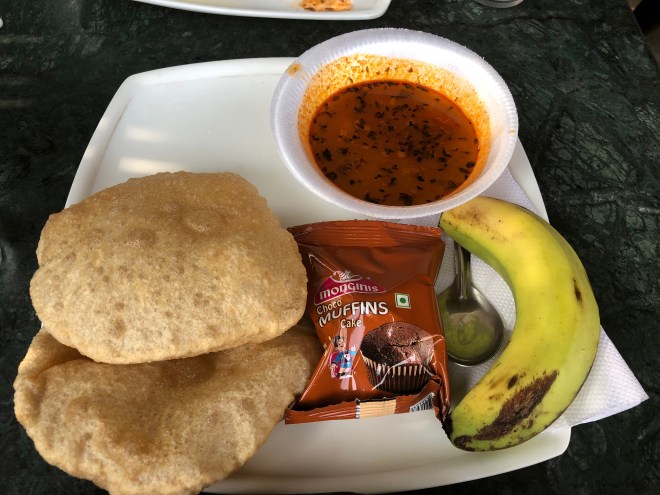
This is an example of a breakfast served by our hotel that includes more traditional food in India. The soup was a very spicy broth with potatoes in it and on the side is fried bread. Most mornings the hotel served omelette sandwiches, but this was a nice change.
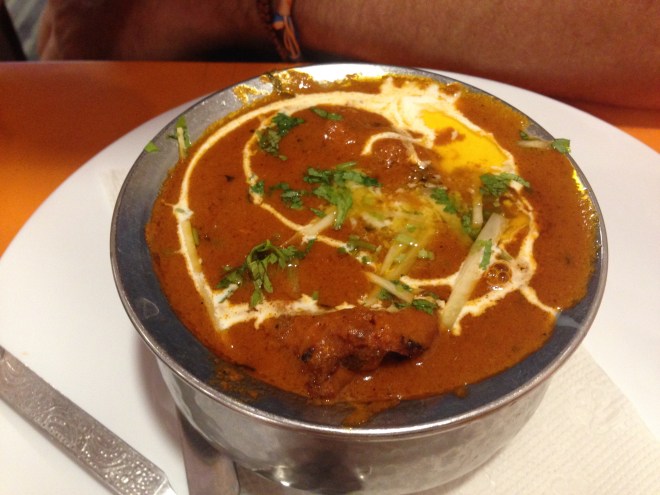
Butter chicken – Delhi is known for this dish and it certainly tasted better than any butter chicken I’ve had at home!
We actually tried on two occasions to visit a butter chicken place in Delhi that a good friend of mine from dubbed “the best chicken in the world,” but on both occasions we were scammed. The first time a taxi driver told us he knew where the restaurant was and ended up dropping us in what we later learned was the opposite side of town (not even next to a chicken place). When we found a taxi to take us back the driver charged us five times less than what we had just paid the other driver, showing us we had been taken in more ways than one. The second time we tried to find the chicken place a different taxi driver told us the chicken place we wanted to go to was closed, but that he would take us to a good restaurant he knew about for free (the chicken place we wanted to go to wasn’t closed, he was just lying to us to give a friend of his business).
Watching out was scam was exhausting, but needed. Another day we were approached with a conversation that certainly stood out, as it was one of the few people who approached us who didn’t want something from us. As we wandered down a side street looking for a grocery store a kind elderly man stopped us and calmly inquired,
“What are you doing here?”
Kirk replied, “We are just looking.”
The man replied, “Was somebody guiding you?”
Kirk said, “Yes, he said we would find a grocery store this way.”
The man’s concerned seemed to fade a little when he realized we were not actually following someone, but the final thing he said as we walked away was, “Don’t trust anyone.”
😬😂.
There are actually several other stories I could tell of people trying to pull one over on us in Delhi, but thankfully no real harm occurred . I’m uncertain if our misfortune was was due to the area of town we were in or if large areas of Delhi are a little sketchy, but it was certainly an interesting experience to consider. I mentioned earlier that I thought population size might play a role into how women are treated, and I can only imagine that population size also plays a role in the amount of begging and scams one encounters also. I’d think that when 28.5 million people are sharing a single city, the anonymity, need to survive, and wealth gap naturally generate a space in which there will be some less than friendly climates. After all, the largest city in the U.S. is New York, and there is certainly more crime there than in any small city in which I’ve lived. Of course one encounters more scams and crime in Delhi – it’s over three times the size of New York!
As far as the rest of our time in Delhi, we did have one day that we were both feeling well enough to adventure outside the area in which our hotel was to see a site. This particular day we decided to visit a place called Akshardham. After visiting many historic places throughout our trip that have stood a heavy test of time, I’ve often found myself asking, “What modern day structure could possibly last as long as these old stone buildings so that someone far in the future can discover something from our generation?” It is quite possible that the temple Akshardham in Delhi is the answer to that question.
Akshardham is a Hindu temple made of pink sandstone and marble that began being built in 2000 and was finished in 2005. The pink stone that makes up the outside of the building is filled from bottom to top with hundreds of intricate carvings of Hindu deities and designs which over 7,000 carvers were used to complete. These decorated walls rise up and peak at nine separate domes that are easily visible even from a long distance away. Alongside the base of the temple, a progression of scenes featuring of nearly lifesized elephants carved out of the same pink sandstone line the building and tell stories from the Hindu faith. The inside of the temple features impressive exquisitely carved white marble around which the story of Swaminarayan (a former yogi, or teacher, in the Hindu faith to whom the temple is dedicated) is told.
Interestingly enough, the temple is only the beginning of the attractions in this humongous gated complex. Entrance to the temple is free, but if you wish, you can sign up for other attractions for a fee such an evening fountain laser light show, an indoor boat ride, a viewing of a film on the largest screen in Delhi, or the journey through a hall of animatronic people who tell the story of Swaminarayan in a robotic fashion. I read that the builders of the temple wanted to mix new elements of art with the old traditional ways to better tell Swaminarayan’s story. It’s a fascinating place.
Unfortunately they don’t allow any type of camera in the complex and they are very strict about this. Every person has to walk through a metal detector and be patted down prior to entering. Any items that aren’t allowed can be left in a storage facility located just outside the temple grounds. Because we had to leave phones behind, the only photo we have is from outside the gate. 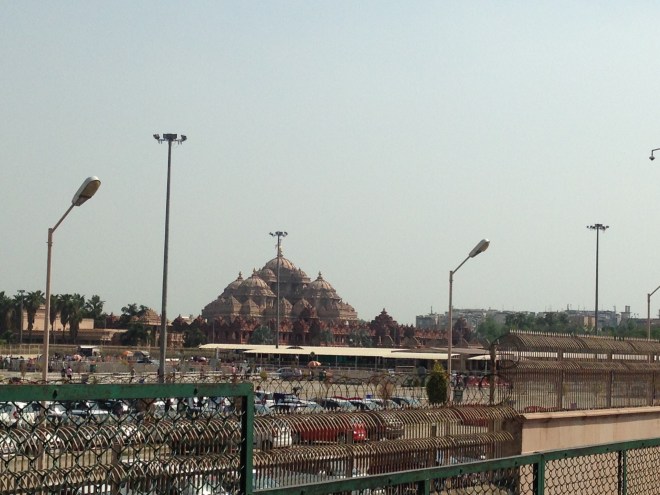
If you are interested in seeing what the temple really looks like, photos can be found in the following link, as well as more information about the temple. It was actually quite impressive and well worth the visit if you find yourself in Delhi.
https://akshardham.com/explore/Mandir/
The day after visiting Akshardham is the day my parents arrived! They flew into Delhi after spending a few days in London, arriving at the hotel at a late 2 am. We were all up bright and early the next morning to catch our 6:30 am hired car to Agra, the home of the Taj Mahal. Unfortunately, I woke up feeling sick for a second time in Delhi this day (though thankfully it turned out o be much milder than the first episode!). I took some medicine to help make it through and made sure to smile big for all the pictures. There was no way I was going to miss out on the Taj Mahal!
After a three hour car ride to Agra we teamed up with a tour guide and hoped in a tuk tuk to take us to the actual entrance of the Taj Mahal.
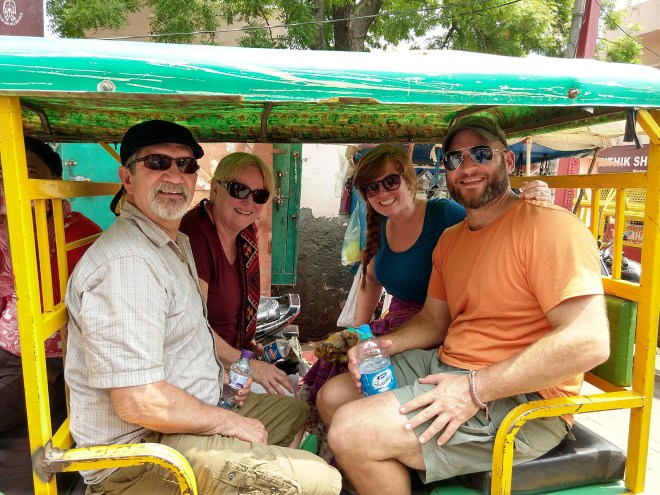
Together, in the tuk tuk.
Inside the entrance of the Taj Mahal area we stopped under a shaded area while our tour guide told us about the history of the building.
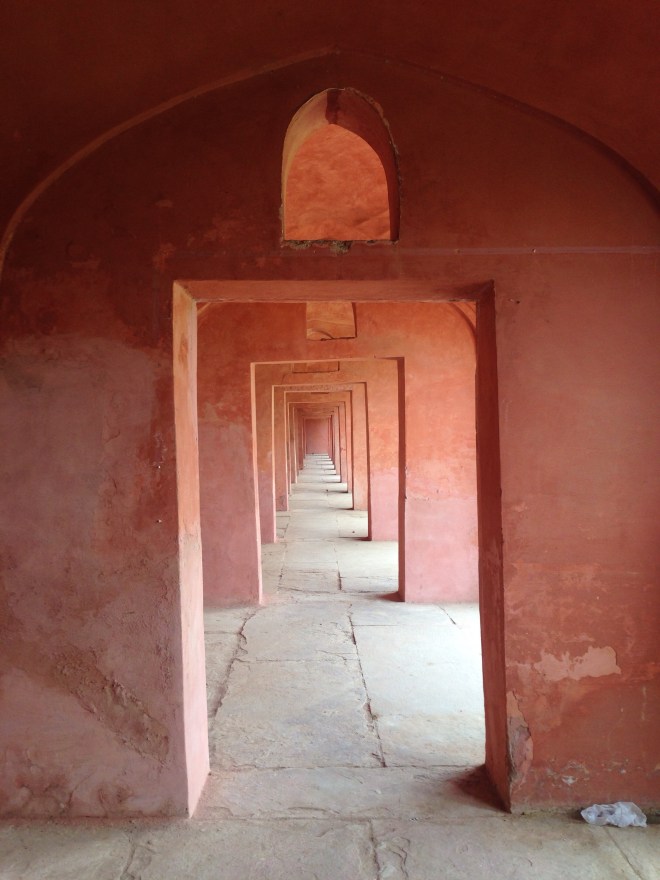
Doorways next to us as we listened to our tour guide’s explanations. I liked the way they looked, especially the way they were not cut perfectly even!
If you haven’t heard the story, the Taj Mahal is a mausoleum built by Emperor Shah Jahan for his favorite wife, Mumtaz Mahal. Apparently the first two wives of the emperor bore him no children, but Mahal, his third wife, bore him 14 children before passing away during the birth of their final child. She died in 1631 and the mausoleum was finished in 1648. In total, it took around 15 years to build this giant stone structure. The entire Taj Mahal is made of intricately designed white marble and is now home to the tombs of both Mahal and the husband who built it for her, Emperor Shah Jahan.
Though this white marble mausoleum is the main attraction of the area, the Taj Mahal is one of several buildings in the Taj Mahal complex.To the left and right of the Taj Mahal are two identical buildings made from sandstone – one, a mosque, and the other, a guesthouse. To the front of the Taj Mahal is an ornate entrance gate. All three of these additional buildings are intricately designed and adorned with precious stones. The entire complex is quite beautiful.

The entrance gate into view the Taj Mahal – my parents and Kirk in view.
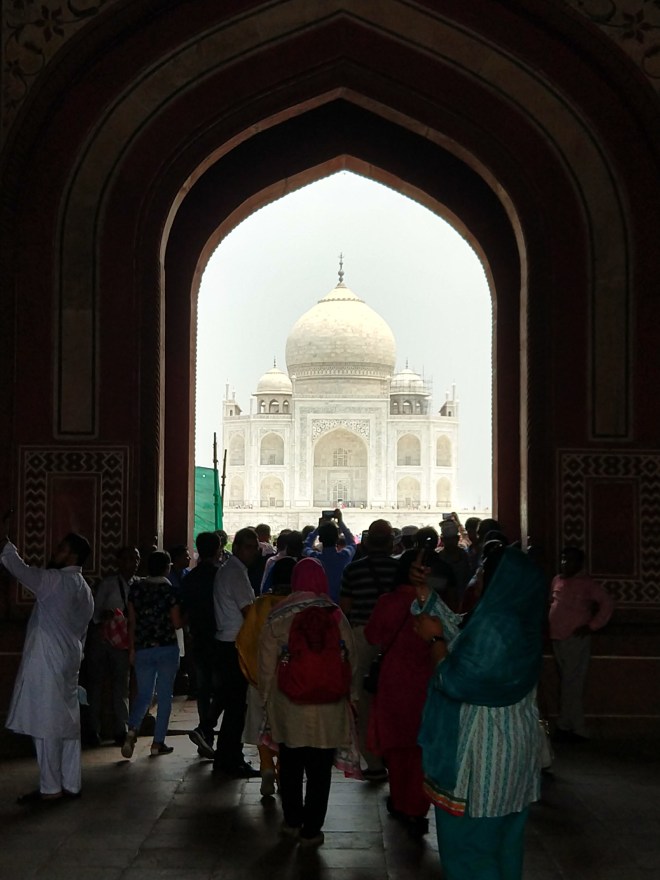
Walking through the entrance gate with the masses. This was our first glimpse of the Taj!

The Taj Mahal and the crowd taking pictures :).

Momma, Kirk, and Daddy following the tour guide towards the Taj Mahal.
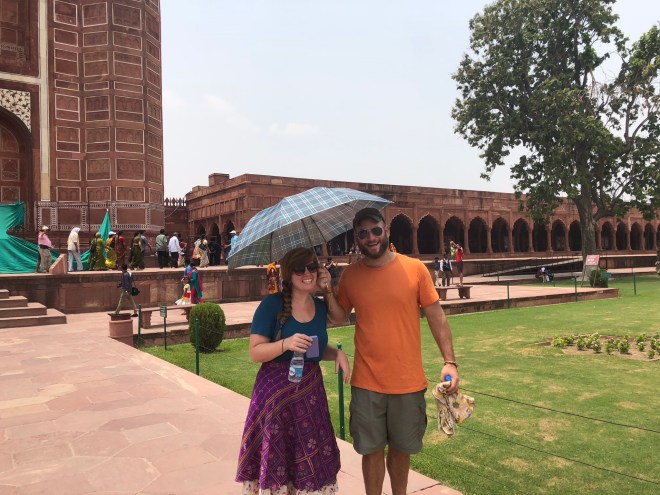
Kirk helped me carry all my things since I wasn’t feeling well and my mom snapped a picture. It was around 102 degrees this day with few clouds in the sky, so that umbrella was very important!
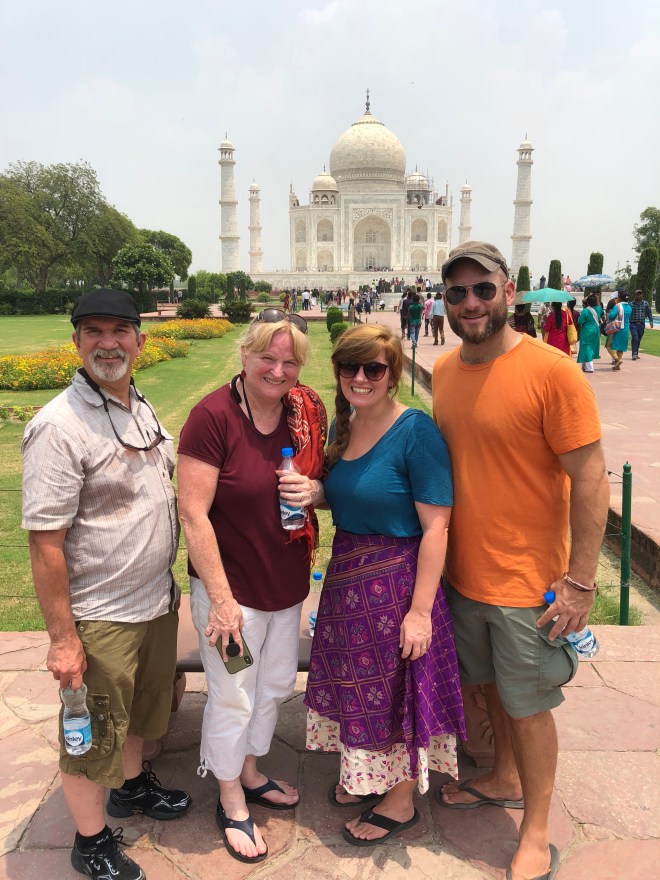
Family pic taken by our tour guide. He then took a bunch of “couple pictures,” but I’ll only post the following from when he said, “Now turn and look at each other!” 😂

Ha! We don’t normally take pictures this posed!
To enter the Taj Mahal we had to wear “slippers” over our shoes.

Kirk in his slippers over his flip flops 🙂
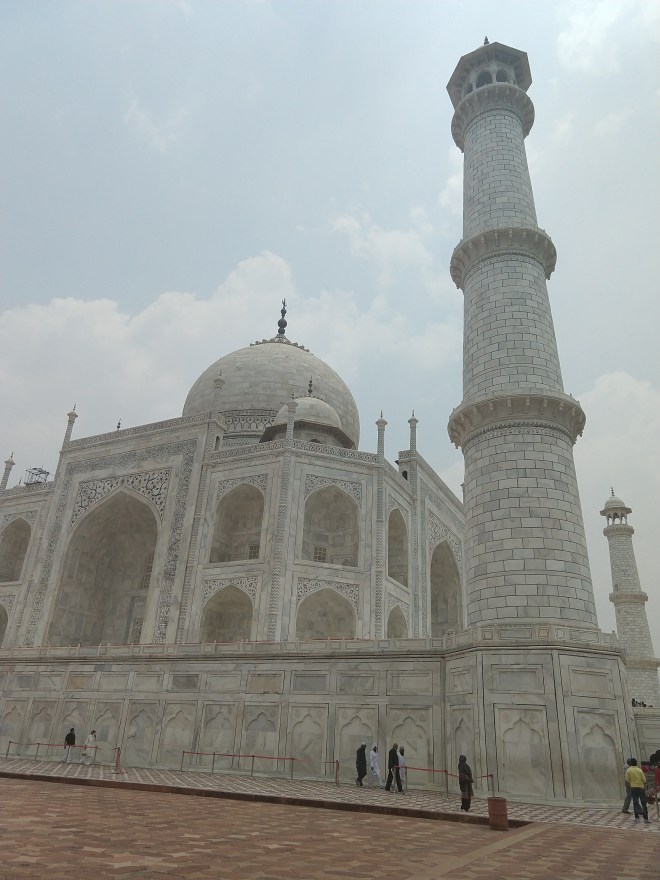
A closer up picture of the Taj Mahal
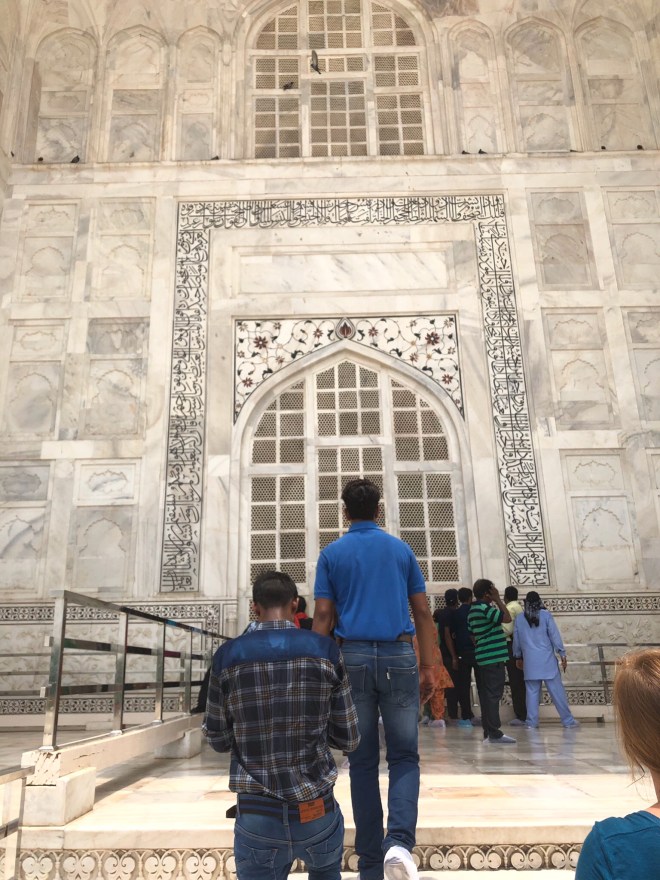
Walking towards the front entrance. Take note of all the details! The main door is surround by “honeycomb” looking lattice that was all chiseled by hand!
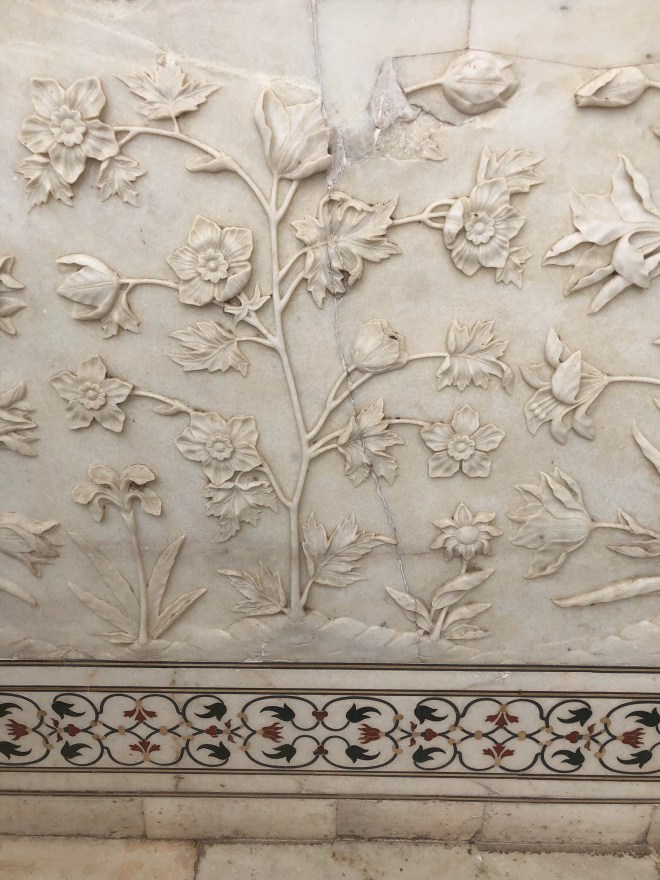
Flowers carved in marble next to the entrance. The colorful design at the bottom is made with stones like rubies and jasper. Though they aren’t the purest version of the stones that you often find on a necklace, they are pretty translucent when a light is shown through them, illuminating a brighter color than what you see here.
Unfortunately photos are not allowed inside the actual mausoleum, so you will have to go see it for yourself :). The inside is filled with marble carvings that are more intricate than anything I knew possible. Floral and vine like designs create a marble lattice that surrounds both tombs. I kept looking at how beautiful it is and wondering how many times a person messed up before getting it right – It’s amazing what people were able to create with only hand tools!
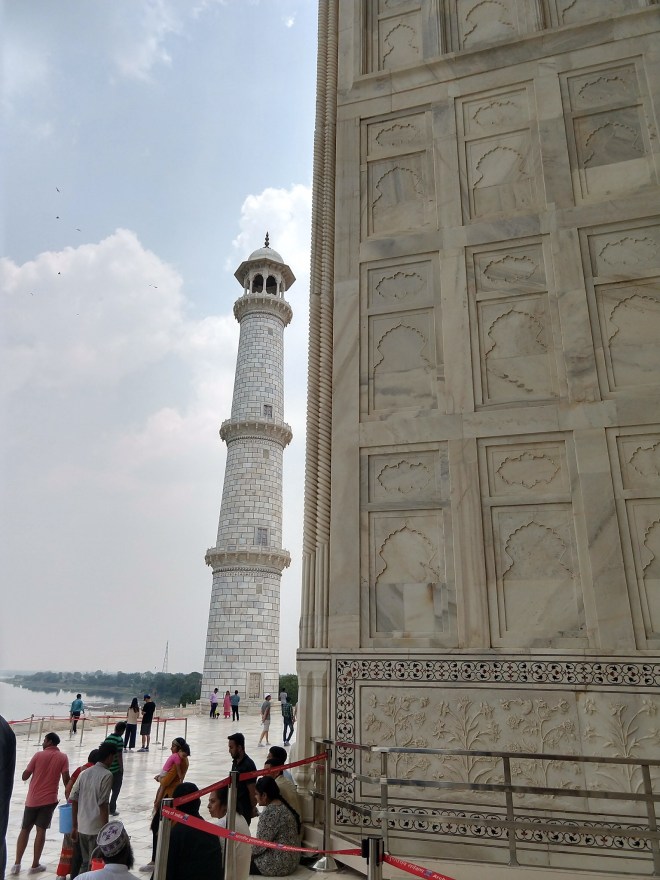
Coming out on the other side of the mausoleum.

Check out the ceiling!

The exit from which we just walked out
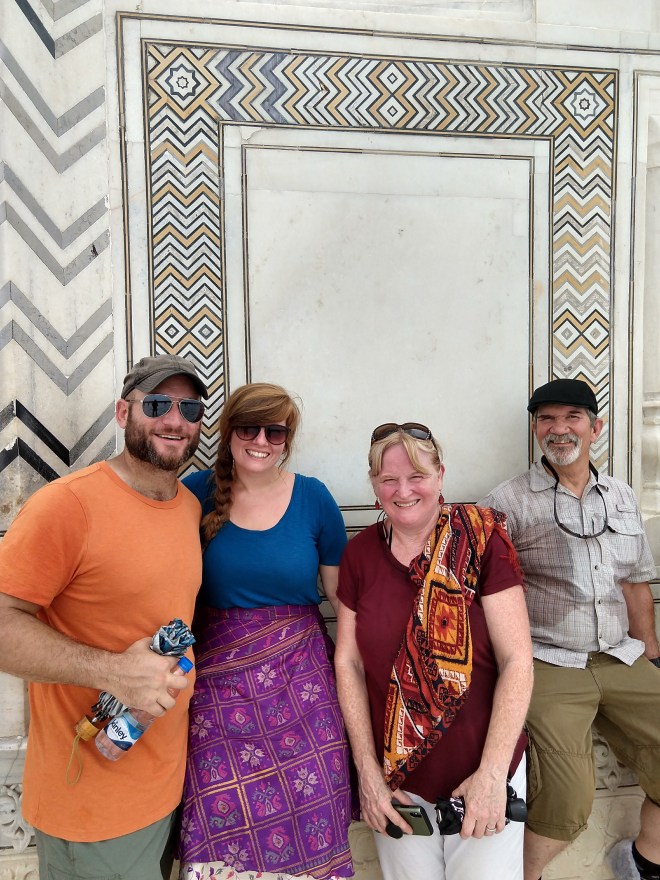
Our tour guide saw that I saw tired and told us to sit. This is us leaning on the backside of the Taj Mahal. Appartently the “chevron” pattern that regained popularity a few years ago has been around a long time!
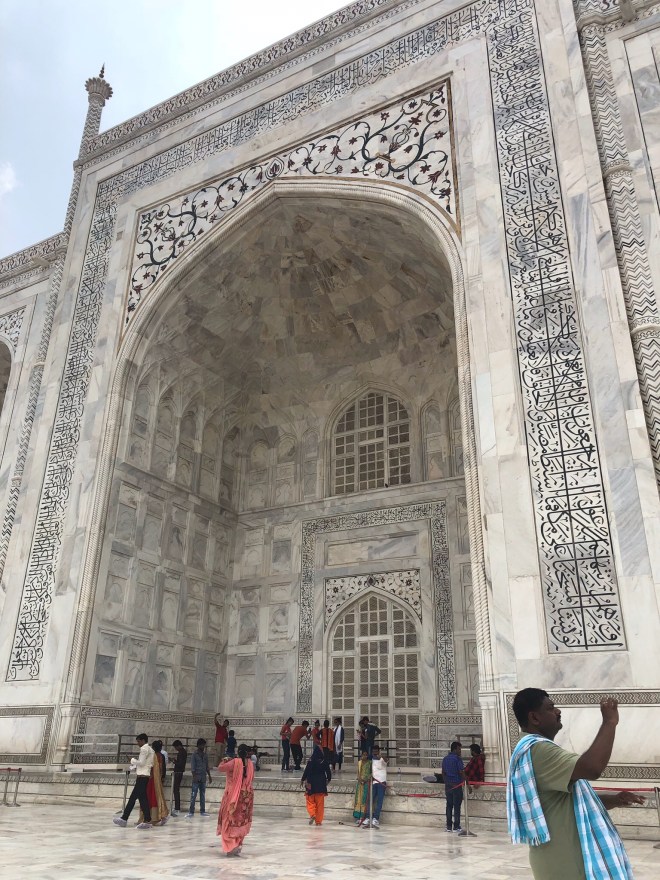
The side entrance to the Taj Mahal that faces the guesthouse.
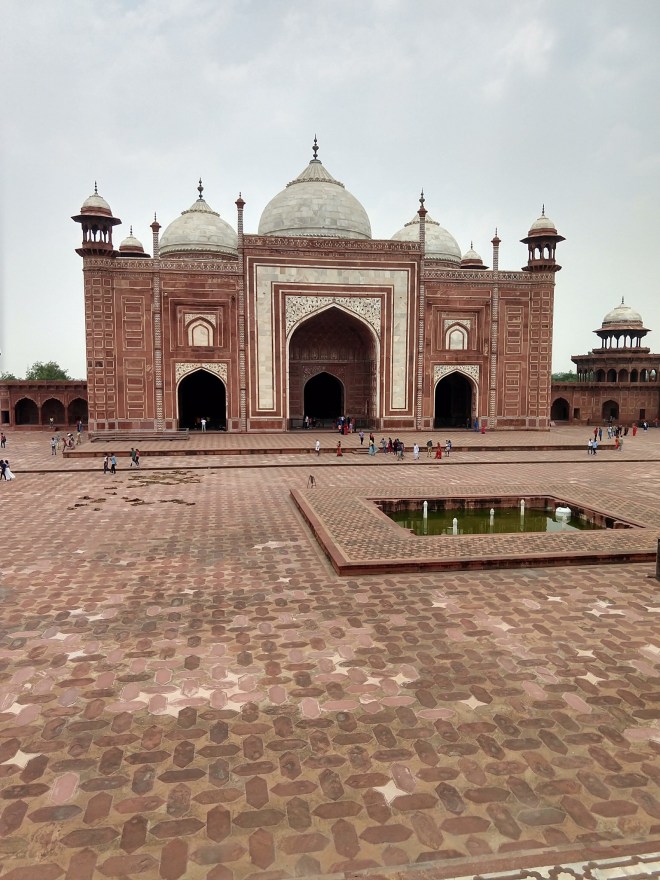
The guesthouse made of red sandstone. Though I don’t have a picture of it, as I mentioned before, there is a mosque that looks identical to this building on the other side of the Taj Mahal.
After eating lunch we hopped back in the car to head back to Delhi. We paused on the way out of town to snap a photo of a section of “Agra Fort.”

The stone color was beautiful!
That evening we walked my parents around a small section of the bazaar area in Delhi on the way to and from dinner. It didn’t seem to stress them out near as much as it did me, but I’m still blaming the illness 😂. In the morning we got up and boarded a plane for Goa, a popular beach destination in India for tourists. The next blog will tie up the rest of our time in India!